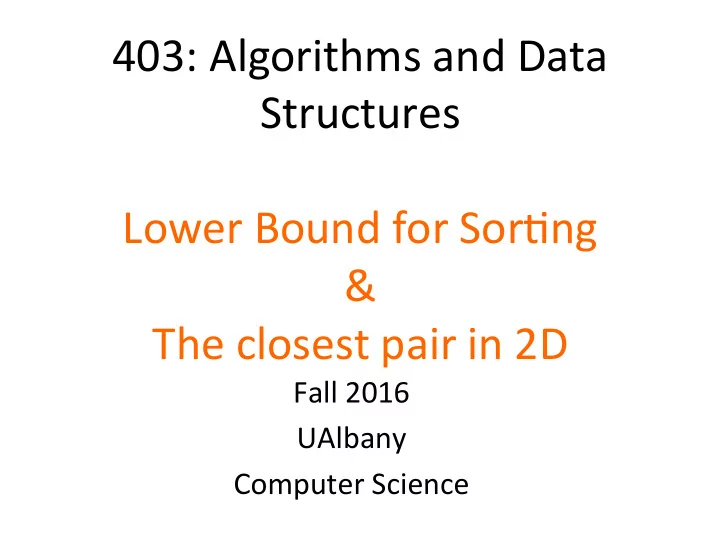

403: Algorithms and Data Structures Lower Bound for Sor<ng & The closest pair in 2D Fall 2016 UAlbany Computer Science
So far: Sor<ng Algorithm Time Space • Inser&on O(n 2 ) in-place • Merge O(n logn) 2 nd array to merge • Heapsort O(n logn) in-place • Quicksort from O(n logn) to O(n 2 ) in-place Can we do beLer than O(n logn) ? Spoiler: Not if we do comparisons only
Lower bound on comparison sorts • Any algorithm performing only comparisons runs in nlogn) • We will prove this using the concept of decision trees
Closest pair in 2D • Given n points in 2-dimensions, find two whose mutual distance is smallest. • Euclidean distance
Closest pair in 2D • Brute force? – Consider all pairs • Complexity? – O(n 2 )
Divide-And-Conquer (1D) • We can simply sort and consider consecu<ve pairs O(nlogn) – Does not generlize to 2D
Divide-And-Conquer (1D) • DIVIDE: split array in two equal parts • CONQUER: recursively find closest pair in parts • COMBINE: – Let d be the smallest separa<on in S1 and S2 – If dist(p3,q3)<d return dist(p3,q3) else d
Divide-And-Conquer (1D) Pseudo code Closest-Pair-1D(S) If |S|= 1, output d = infinity If |S|= 2, output d= |p2-p1| Otherwise, do the following steps: 1. Let m = median(S) 2. Divide S into S1, S2 at m. 3. d1 = Closest-Pair-1D(S1). 4. d2 = Closest-Pair-1D(S2). 5. d12 is minimum distance across the cut. 6. Return d = min(d1; d2; d12)
Divide-And-Conquer (1D) • Key observa<on: If m is the dividing coordinate, then p3, q3 must be within d of m. – p3 must be the rightmost point in S1 – q3 must be the ledmost point in S2 – Hard to generalize to 2D • How many points of S1 can be in (m-d,m]?
Divide-And-Conquer (2D) • DIVIDE: split points in two equal parts with line L • CONQUER: recursively find closest pair in parts • COMBINE: – d=min(d led ,d right ) – d is the answer unless L split points that are close
Region near L • If there is a pair (p,q) within distance d split by L, then both p and q must be within d from L • Let Sy be an array of points in the region sorted by y coordinate • size of Sy might be O(|S|) – Cannot check all pairs
Special structure in Sy • Let: Sy=p1,p2…pm , then if dist(p i ,p j )<d then j-i<=15 • close-by points are closeby in the array
Proof: close points within 15 posi<ons • Divide the region in squares of side d/2 • How many points in each box? • At most 1 – Each box in contained in one half – No 2 points in a half are closer than d
Proof: close points within 15 posi<ons • Suppose 2 points separated by 15 indices • At least 3 full rows separate them • Height of 3 rows >3d/2 > d • Points are farther than d from each other
Divide and Conquer(2D) ClosestPair(ptsX, ptsY) DIVIDE 1. if ( size(ptsX)<2 ) return null 2. if ( size(ptsX)==2 ) return ptsX 3. m =median of x coordinates 4. Prepare subsets to the led of m: ptsX-leT, ptsY-leT and to the right of m: ptsX-right, ptsY-right // They should be sorted but you should not use sor<ng (see book chapter) 5. pair-leT = ClosestPair(ptsX-led, ptsY-led) CONQUER 6. pair-right = ClosestPair(ptsX-right, ptsY-right) 7. d = min of distances between pair-leT and pair-right 8. res = pair among pair-leT and pair-right of the smaller distance 9. ptsWithinD : an array of points within distance d from m , sorted by y coordinates 10. for i =1… ptsWithinD.length 11. for j = i +1…min( ptsWithinD.length , i +15) 12. if dist( ptsWithinD[i], ptsWithinD[j])<d 13. res = (ptsWithinD[ i ], ptsWithinD[ j ]) 14. b = dist(ptsWithinD[ i ], ptsWithinD[ j ]) 15. return res COMBINE: O(n)
Analysis • Divide set of points in half each <me: – depth of recursion is O(log n) • Merge takes O(n) <me. • Recurrence: T(n) = 2T(n/2) + cn • Same as MergeSort: O(n log n) <me.
Recommend
More recommend